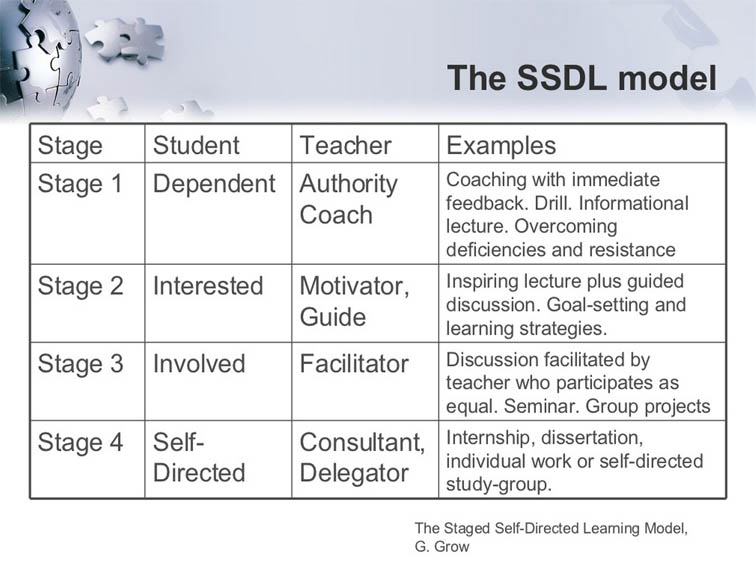by Staff
Autonomous learning is not a new concept, but it is often misunderstood, especially in the context of class K-12 rooms.
In a previous reflection, Terry Heick explored the relationship between autonomous learning and the real objective of education:
“The objective of the model is not knowledge of the content (although it should produce this), but rather something closer to wisdom – by learning to learn, to understand what is worth understanding, and perhaps above all to analyze the goal of learning (for example, a personal and social change).
Autonomous learning is gaining ground while educators seek to modernize teaching practices. Because dissatisfaction with regard to traditional education is developing and with the richness of online resources available in the Information ageIt is a powerful framework to help learners prosper independently. This model, popularized by Gerald Grow, breaks the trip in Four stages of autonomous learning– Clearly reflecting the gradual release of officials that teachers already know it well.


Step 1: Dependent (teacher as a authority and coach)
At this stage, students are counting almost entirely on teachers to introduce knowledge, provide a structure and guide their learning. They do not have confidence and skills to learn independently.
- Role of the teacher: Act as a coach and authority, by offering clear instructions and immediate comments to develop fundamental skills.
- Practical strategies:
- Present to students new ideas via direct education, guided practice and scaffolding.
- Use adaptive platforms like Khan Academy for structured skills strengthening exercises.
- Create safe opportunities for students to take small risks without fear of failure.
Step 2: Interested (teacher as motivator and guide)
Students are starting to demonstrate curiosity and take the initiative, but are always based on the teacher for the structure and encouragement.
- Role of the teacher: Motivate and guide students, promote commitment through links with real experiences.
- Practical strategies:
- Use real learning and based on projects to make the content significant and inspire an investigation.
- Gamify lessons with tools like Classcraft or Quizizz to maintain commitment.
- Include lessons on establishing objectives and self -management, helping students explore their own interests in structured parameters.
Step 3: involved (teacher as a facilitator)
Here, students play an active role in their own learning. They can set objectives, collaborate with their peers and manage tasks with minimum supervision.
- Role of the teacher: Facilitate by being a guide on the side, promoting the activities led by students while providing support if necessary.
- Practical strategies:
- Encourage students focused on students through group projects or seminar style discussions. Use tools like Google Workspace to support teamwork.
- Present research -based learning, promoting critical thinking because students use research to ask and answer their own questions.
- Provide students with choice menus or flexible executives for projects, giving them autonomy while maintaining the limits.
Step 4: Self-driven (teacher as a consultant and delegate)
Students are now fulfilling their full responsibility for their learning, the independent fixation of objectives, monitoring of progress and the search for resources. Teachers go into a advice role, offering comments and support only as requested.
- Role of the teacher: Act as a consultant or delegate, getting away to allow students to appropriate.
- Practical strategies:
- Assign passionate projects or independent research tasks to encourage autonomy.
- Use tools such as the concept or reflective learning reviews to monitor objectives and progress.
- Incorporate the responsibility of the peers, where students share objectives and provide comments.
The purpose of autonomous learning
The ultimate objective of self -owned learning is not only controlling content but achieving something closer to wisdom– Learn to learn and understand Why Learning issues. This model encourages students to explore the relationship between study and real world applications such as work, citizenship and personal growth.
With effective advice through these four stages, self-directed learners discover their Need to know And develop skills that transcend the classroom. It is not only about knowledge – it is a question of preparing students to adapt, grow and innovate in a constantly evolving world.
Additional resources:
The four stages of the autonomous learning model
Learner Teacher
Step 1 Dependent authority, coach
Examples: Coaching with immediate feedback. Pierce. Information conference. Overcome gaps and resistance.
Step 2: Interested motivator, guide
Examples: Inspiring conference more guided discussion. Objectives and learning strategies.
Step 3: Facilitator involved
Examples: discussion facilitated by the teacher who participates. Seminar. Group projects.
Step 4: Self-driven consultant, delegate
Examples: internship, thesis, individual work or autonomous study group.
Theories of teaching and learning: the self -edited learning model staged, G.Grow. Since Barbara Stokes; Four steps of an autonomous learning model
Teachthought’s mission is to promote critical thinking and innovation education.



